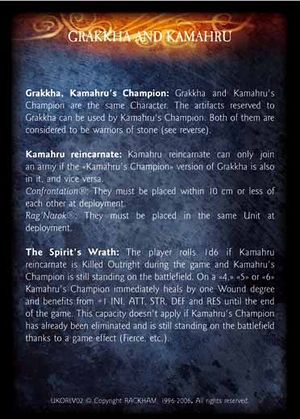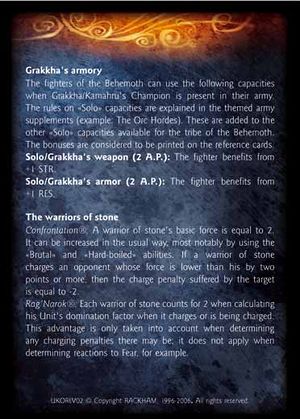Grakkha and Kamahru
Grakkha, Kamahru's Champion: Grakkha and Kamahru's Champion are the same Character. The artifacts reserved to Grakkha can be used by Kamahru's Champion. Both of them are considered to be warriors of stone (see below).
Kamahru Reincarnate: Kamahru Reincarnate can only join an army if we Kamahru's Champion, version of Grakkha is also in it, and vice versa.
- Confrontation: They must be placed within 10 cm or less of each other at deployment.
- Rag'Narok: They must be placed in the same Unit at deployment.
The Spirit's Wrath: The player rolls 1d6 if Kamahru Reincarnate is KILLED OUTRIGHT during the game and Kamahru's Champion is still standing on the battlefield. On a 4, 5, or 6 Kamahru's Champion immediately heals by one Wound degree and benefits from +1 INI, ATT. STR. DEF and RES until the end of the game, This capacity doesn't apply if Kamahru's Champion has already been eliminated and is still standing on the battlefield thanks to a game effect (<Fierce>, etc.)
Grakkha's Armory: The fighters of the Behemoth can use the following capacities when Grakkha/Kamahru's Champion is present in their army. The rules on "Solo" capacities are explained in the theme army supplements (example: The Orcish Hordes). These are added to the other "Solo" capacities available for the Tribe of the Behemoth. The Bonuses are considered to be printed on their reference cards.
Solo / Grakkha's Weapon (2 A.P.): The fighter benefits from +1 STR.
Solo / Grakkha's Armor (2 A.P.): The fighter benefits from +1 RES.
The Warriors of Stone
Confrontation: A warrior of stone's basic force is equal to 2. It can be increased in the usual way, most notably by using the <Brutal> and <Hard-Boiled> abilities. If a warrior of stone charges an opponent whose force is lower than his by two points or more, then the charge penalty suffered by the target is equal to -2.
Rag'Narok: Each warrior of stone counts for 2 when calculating the Unit's domination factor when it charges or is being charged. This advantage is only taken into account when determining any charging penalties there may be, it does not apply when determining reactions to Fear, for example.

